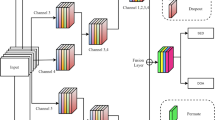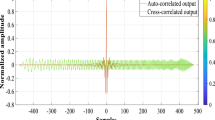Abstract
In this paper, a classification method based on convolutional neural network (CNN) and received signal strength (RSS) is proposed to solve the problem of non-cooperative emitter beam state sensing in electrical situational awareness. RSS, sensor coordinates, and received signal frequency are taken as the input features of CNN, while real state is taken as the output of CNN. To increase the RSS gradient contained in the eigenvector, a multi-layer sensor array is proposed to measure RSS. Simulation results show that the proposed method is robust to array location disturbance, and has the ability to generalize the mismatches in target location and main lobe beam width between first nulls.
摘要
本文提出了一种基于卷积神经网络(CNN)和接收信号强度(RSS)的分类方法,以解决态势感知中的非合作辐射源波束状态感知问题。以RSS、传感器坐标和接收信号频率作为CNN的输入特征,真实波束状态作为CNN的输出。为了增加特征向量中包含的RSS梯度变化,提出了一种多层观测阵列来测量RSS。仿真结果表明,该方法对接收阵列位置扰动具有鲁棒性,对目标位置失配和主瓣第一零点宽度失配具有泛化能力。
Similar content being viewed by others
References
QIN Z J, GAO Y, PLUMBLEY M D, et al. Wideband spectrum sensing on real-time signals at sub-Nyquist sampling rates in single and cooperative multiple nodes [J]. IEEE Transactions on Signal Processing, 2016, 64(12): 3106–3117.
MEHANNA O, SIDIROPOULOS N D. Maximum likelihood passive and active sensing of wideband power spectra from few bits [J]. IEEE Transactions on Signal Processing, 2015, 63(6): 1391–1403.
YU Z, WANG Y, CHEN C. Radar emitter signal sorting method based on density clustering algorithm of signal aliasing degree judgment[C]// 2020 15th IEEE Conference on Industrial Electronics and Applications. Kristiansand: IEEE, 2020: 1027–1031.
PAN Z S, WANG S F, ZHU M T, et al. Automatic waveform recognition of overlapping LPI radar signals based on multi-instance multi-label learning [J]. IEEE Signal Processing Letters, 2020, 27: 1275–1279.
AZPÚRUA M A, POUS M, SILVA F. Decomposition of electromagnetic interferences in the time-domain [J]. IEEE Transactions on Electromagnetic Compatibility, 2016, 58(2): 385–392.
LI P, ZHOU Z Y, SHENG M J. Identification of electromagnetic interferences based on adaptive sparsest time-frequency analysis [C]//2018 IEEE International Symposium on Electromagnetic Compatibility and 2018 IEEE Asia-Pacific Symposium on Electromagnetic Compatibility. Suntec City: IEEE, 2018: 761–765.
HE R M, XU Z F, WANG L H, et al. Research on 3D visualization technology of electromagnetic field based on OSG [C]//2017 10th International Symposium on Computational Intelligence and Design. Hangzhou: IEEE, 2017: 75–78.
TITOV E V, SOSHNIKOV A A, DROBYAZKO O N. Experimental research of electromagnetic environment in domestic environment with computer visualization of electromagnetic pollution[C]// 2020 International Conference on Industrial Engineering, Applications and Manufacturing. Sochi: IEEE, 2020: 1–5.
WANG G, CHEN H, LI Y M, et al. On received-signal-strength based localization with unknown transmit power and path loss exponent [J]. IEEE Wireless Communications Letters, 2012, 1(5): 536–539.
Author information
Authors and Affiliations
Corresponding author
Additional information
Foundation item
the National Natural Science Foundation of China (No. 62071137), the Fundamental Research Funds for Central Universities (No. 3072021CF0816), and the Key Laboratory of Advanced Marine Communication and Information Technology, Ministry of Industry and Information Technology Project (No. AMCIT2102-04)
Rights and permissions
About this article
Cite this article
Jiang, Y., Li, X. & Zhang, H. Emitter Beam State Sensing Based on Convolutional Neural Network and Received Signal Strength. J. Shanghai Jiaotong Univ. (Sci.) (2023). https://doi.org/10.1007/s12204-023-2582-2
Received:
Accepted:
Published:
DOI: https://doi.org/10.1007/s12204-023-2582-2
Key words
- electromagnetic situation awareness
- convolutional neural network (CNN)
- received signal strength (RSS)
- emitter beam pointing




